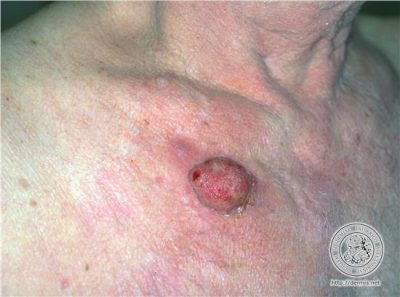SERVICES
- Allergy Screening
- Chemical Peels
- Dermapen
- Facial Skin Analysis
- FreshEyes
- Hyperhidrosis (Excessive Sweating)
- Hair Loss Treatment
- Laser Clinic
- Liquid Facelift
- Keloid Treatments
- Medical Facials
- Medical Treatments
- Mole Mapping
- Photodynamic Therapy (PDT)
- Skincare Advice
- Pigmentation Treatment
- Surgical Procedures
- Ultraviolet Phototherapy
USEFUL LINKS
The Second Most Common Form of Skin Cancer
 Squamous cell carcinoma (SCC) is an uncontrolled growth of abnormal cells arising in the squamous cells, which compose most of the skin’s upper layers (the epidermis). SCCs often look like scaly red patches, open sores, elevated growths with a central depression, or warts; they may crust or bleed. SCC is mainly caused by cumulative UV exposure over the course of a lifetime. It can become disfiguring and sometimes deadly if allowed to grow. An estimated 700,000 cases of SCC are diagnosed each year in the US, resulting in approximately 2,500 deaths.
Squamous cell carcinoma (SCC) is an uncontrolled growth of abnormal cells arising in the squamous cells, which compose most of the skin’s upper layers (the epidermis). SCCs often look like scaly red patches, open sores, elevated growths with a central depression, or warts; they may crust or bleed. SCC is mainly caused by cumulative UV exposure over the course of a lifetime. It can become disfiguring and sometimes deadly if allowed to grow. An estimated 700,000 cases of SCC are diagnosed each year in the US, resulting in approximately 2,500 deaths.
SCCs may occur on all areas of the body including the mucous membranes and genitals, but are most common in areas frequently exposed to the sun, such as the rim of the ear, lower lip, face, bald scalp, neck, hands, arms and legs. Often the skin in these areas reveals telltale signs of sun damage, such as wrinkling, changes in pigmentation, and loss of elasticity.
What to Look For
Squamous cell carcinomas typically appear as a persistent thick, rough, scaly patch that can bleed if bumped. They often look like warts and sometimes appear as open sores with a raised border and a crusted surface over an elevated pebbly base.
Who Gets It
People who have fair skin, light hair, and blue, green, or gray eyes are at highest risk of developing the disease. But anyone with a history of substantial sun exposure is at increased risk. Those whose occupations require long hours outdoors or who spend extensive leisure time in the sun are in particular jeopardy. Anyone who has had a basal cell carcinoma is also more likely to develop an squamous cell carcinoma, as is anyone with an inherited, highly UV-sensitive condition such as xeroderma pigmentosum.
Squamous cell carcinomas are at least twice as frequent in men as in women. They rarely appear before age 50 and are most often seen in individuals in their 70s.
The majority of skin cancers in African-Americans are squamous cell carcinomas, usually arising on the sites of preexisting inflammatory skin conditions or burn injuries. Though naturally dark-skinned people are less likely than fair-skinned people to get skin cancer, it is still essential for them to practice sun protection.
Causes
Chronic exposure to sunlight causes most cases of squamous cell carcinoma. Frequent use of tanning beds also multiplies the risk of squamous cell carcinoma; people who use tanning beds are 2.5 times more likely to develop squamous cell carcinoma than those who don’t. But skin injuries are another important source. The cancer can arise in burns, scars, ulcers, long-standing sores and sites previously exposed to X-rays or certain chemicals (such as arsenic and petroleum by-products).
Chronic infections and skin inflammation can also give rise to squamous cell carcinoma. Furthermore, HIV and other immune deficiency diseases, chemotherapy, anti-rejection drugs used in organ transplantation, and even excessive sun exposure itself all weaken the immune system, making it harder to fight off disease and thus increasing the risk of squamous cell carcinoma and other skin cancers.
Occasionally, squamous cell carcinomas arise spontaneously on what appears to be normal, healthy skin. Some researchers believe the tendency to develop these cancers can be inherited.
Precancers, the First Step
Certain precancerous growths, or precancers, most of them resulting from cumulative sun damage, can be associated with the later development of squamous cell carcinoma.
Actinic, or Solar, Keratoses
These rough, scaly, slightly raised growths, ranging in color from brown to red and from about 1 mm to 1 inch in diameter, are found on sun-exposed areas of the body, most often in older people. They can be the first step on the road to squamous cell carcinoma, and some experts even consider them the earliest form of squamous cell carcinoma. From two to ten percent of untreated actinic keratoses (AK) advance to squamous cell carcinoma, according to different studies. Indeed, 40 to 60 percent of squamous cell carcinomas begin as untreated actinic keratoses.
Actinic cheilitis
This form of actinic keratosis occurs most often on the lower lip, causing it to become dry, cracked, scaly and pale or white. Why the lower lip? Because it receives more sun exposure than the upper lip. If not treated promptly, actinic cheilitis can lead to squamous cell carcinoma on the lip.
Leukoplakia
Arising in the mucous membranes, these white patches on the tongue, gums, cheeks, or elsewhere inside the mouth have the potential to develop into squamous cell carcinoma. They may be caused by sources of chronic irritation, such as habitual alcohol consumption or tobacco use, or rough edges on teeth or dentures. They may even be caused by a long-time habit of biting the inside of the lip; however, leukoplakias on the lips are mainly caused by sun damage.
Bowen’s Disease
This is now generally considered an early, noninvasive stage of squamous cell carcinoma. It appears as a persistent red-brown, scaly patch that may resemble psoriasis or eczema. If untreated, it may invade deeper structures. Bowen’s disease is most often caused by exposure to the sun or to arsenic, but other chemical carcinogens, radiation, genetics and trauma also may play a role. The human Papillomavirus (HPV), highly transmissible through sexual contact, has been documented as a cause of one form of Bowen’s disease affecting the genitals. The disease can arise in the mucous membranes of the nose and mouth as well as on the skin. In 2006, the FDA approved an HPV vaccine for use by females aged 9—26; it is considered highly effective in preventing HPV and thereby reducing the risk of both genital warts and cervical cancer as well as Bowen’s disease.
Treatment Options
Squamous cell carcinomas detected at an early stage and removed promptly are almost always curable and cause minimal damage. However, left untreated, they eventually penetrate the underlying tissues and can become disfiguring. A small percentage even metastasize to distant tissues and organs and can become fatal. Therefore, any suspicious growth should be seen by a physician without delay. A tissue sample (biopsy) will be examined under a microscope to arrive at a diagnosis. If tumor cells are present, treatment is required.
Fortunately, there are several effective ways to eradicate squamous cell carcinoma. The choice of treatment is based on the type, size, location, and depth of penetration of the tumor, as well as the patient’s age and general health.
Treatment can almost always be performed on an outpatient basis in a physician’s office or at a clinic. A local anesthetic is used during most surgical procedures. Pain or discomfort is usually minimal with most techniques, and there is rarely much pain afterwards.
Mohs Micrographic Surgery
Using a scalpel or curette (a sharp, ring-shaped instrument), the physician removes the visible tumor with a very thin layer of tissue around it. This layer is immediately checked under a microscope thoroughly. If tumor is still present in the depths or peripheries of this surrounding tissue, the procedure is repeated until the last layer viewed under the microscope is tumor-free. Mohs saves the greatest amount of healthy tissue, appears to reduce the rate of local recurrence, and has the highest overall cure rate – about 94-99 percent – of any treatment for squamous cell carcinoma. It is frequently used on tumors that have recurred, are poorly demarcated, or are in hard-to-treat, critical areas around the eyes, nose, lips, and ears, as well as the neck, hands and feet. After removal of the skin cancer, the wound may be allowed to heal naturally or be reconstructed using plastic surgery methods.
Excisional Surgery
The physician uses a scalpel to remove the entire growth, along with a surrounding border of apparently normal skin as a safety margin. The wound around the surgical site is then closed with sutures (stitches). The excised tissue is then sent to the laboratory for microscopic examination to verify that all cancerous cells have been removed. The accepted cure rate for primary tumors with this technique is about 92 percent. This rate drops to 77 percent for recurrent squamous cell carcinomas.
Curettage and Electrodesiccation (Electrosurgery)
The growth is scraped off with a curette, and burning heat produced by an electrocautery needle destroys residual tumor and controls bleeding. This procedure is typically repeated a few times, a deeper layer of tissue being scraped and burned each time to help ensure that no tumor cells remain. It can produce cure rates approaching those of surgical excision for superficially invasive squamous cell carcinomas without high-risk characteristics. However, it is not considered as effective for more invasive, aggressive squamous cell carcinomas or those in high-risk or difficult sites, such as the eyelids, genitalia, lips and ears.
Cryosurgery
The physician destroys the tumor tissue by freezing it with liquid nitrogen, using a cotton-tipped applicator or spray device. There is no cutting or bleeding, and no anesthesia is required. The procedure may be repeated several times at the same session to help ensure destruction of all malignant cells. The growth becomes crusted and scabbed, and usually falls off within weeks. Redness, swelling, blistering and crusting can occur following treatment, and in dark-skinned patients, some pigment may be lost. Inexpensive and easy to administer, cryosurgery may be the treatment of choice for patients with bleeding disorders or intolerance to anesthesia. However, it has a lower overall cure rate than the surgical methods. Depending on the physician’s expertise, the 5-year cure rate can be 95 percent or higher with selected, generally superficial squamous cell carcinoma; but cryosurgery is not often used today for invasive squamous cell carcinoma because deeper portions of the tumor may be missed and because scar tissue at the cryotherapy site might obscure a recurrence.
Radiation
X-ray beams are directed at the tumor, with no need for cutting or anesthesia. Destruction of the tumor usually requires a series of treatments, administered several times a week for one to four weeks, or sometimes daily for onemonth. Cure rates range widely, from about 85 to 95 percent, and the technique can involve long-term cosmetic problems and radiation risks, as well as multiple visits. For these reasons, this therapy is mainly used for tumors that are hard to treat surgically, as well as patients for whom surgery is not advised, such as the elderly or those in poor health.
Photodynamic Therapy (PDT)
PDT can be especially useful for growths on the face and scalp. A photosensitizing agent, such as topical 5-aminolevulinic acid (5-ALA), is applied to the growths at the physician’s office; it is taken up by the abnormal cells. The next day, the patient returns, and those medicated areas are activated by a strong light. The treatment selectively destroys squamous cell carcinomas while causing minimal damage to surrounding normal tissue. However, the treatment is not yet FDA-approved for squamous cell carcinoma, and while it may be effective with early, noninvasive tumors, overall recurrence rates vary considerably (from 0 to 52 percent), so the technique is not currently recommended for invasive squamous cell carcinoma. Redness and swelling are common side effects. After treatment, patients become locally photosensitive for 48 hours where the 5-ALA was applied, and must avoid the sun.
Laser Surgery
The skin’s outer layer and variable amounts of deeper skin are removed using a carbon dioxide or erbium YAG laser. This method is bloodless, and gives the physician good control over the depth of tissue removed. It actually seals blood vessels as it cuts, making it useful for patients with bleeding disorders, and it is also sometimes used when other treatments have failed. But the risks of scarring and pigment loss are slightly greater than with other techniques, and recurrence rates are similar to those of PDT. The technique is not yet FDA-approved for squamous cell carcinoma.
Topical Medications
5-fluorouracil (5-FU) and imiquimod, both FDA-approved for treatment of actinic keratoses and superficial basal cell carcinomas, are also being tested for the treatment of some superficial squamous cell carcinomas. Successful treatment of Bowen’s disease, a noninvasive squamous cell carcinoma, has been reported. However, invasive squamous cell carcinoma should not be treated with 5-FU. Some trials have shown that imiquimod may be effective with certain invasive squamous cell carcinomas, but it is not yet FDA-approved for this purpose. Imiquimod stimulates the immune system to produce interferon, a chemical that attacks cancerous and precancerous cells.
Not To Be Ignored
Squamous cell carcinomas usually remain confined to the epidermis (the top skin layer) for some time. However, the larger these tumors grow, the more extensive the treatment needed. They eventually penetrate the underlying tissues, which can lead to major disfigurement, sometimes even the loss of a nose, eye or ear. A small percentage – estimates run from 2 to almost 10 percent – spread (metastasize) to distant tissues and organs. When this happens, squamous cell carcinomas frequently can be life-threatening. About 2,500 deaths result each year in the U.S.
Metastases most often arise on sites of chronic inflammatory skin conditions and on the ear, nose, lip, and mucosal regions, including the mouth, nostrils, genitals, anus, and the lining of the internal organs.
Because most treatment options involve cutting, some scarring from the tumor removal should be expected. This is most often cosmetically acceptable when the cancer is small, but removal of a larger tumor often requires reconstructive surgery, involving a skin graft or flap to cover the defect.
Recurrence and Prevention
Anyone who has had one squamous cell tumor has an increased chance of developing another, especially in the same skin area or nearby. That is usually because the skin has already suffered irreversible sun damage. Such recurrences typically occur within the first two years after surgery. A squamous cell carcinoma can recur even when it has been carefully removed the first time.
Thus, it is crucial to pay particular attention to any previously treated site, and any changes noted should be shown immediately to a physician. squamous cell carcinomas on the nose, ears, and lips are especially prone to recurrence. Even if no suspicious signs are noticed, regularly scheduled follow-up visits including total-body skin exams are an essential part of post-treatment care. Should the cancer return, the physician may recommend a different type of treatment the next time; certain methods, such as Mohs micrographic surgery, can be highly effective for recurrences.
Preventing Skin Cancer
While squamous cell carcinomas and other skin cancers are almost always curable when detected and treated early, it is best to prevent them in the first place. Make these sun safety habits part of your daily health care routine:
- Seek the shade, especially between 10 AM and 4 PM.
- Do not burn.
- Avoid tanning and UV tanning booths.
- Cover up with clothing, including a broad-brimmed hat and UV-blocking sunglasses.
- Use a broad spectrum (UVA/UVB) sunscreen with an SPF of 15 or higher every day. For extended outdoor activity, use a water-resistant, broad spectrum (UVA/UVB)
sunscreen with an SPF of 30 or higher. - Apply 1 ounce (2 tablespoons) of sunscreen to your entire body 30 minutes before going outside. Reapply every two hours or immediately after swimming or excessive sweating.
- Keep newborns out of the sun. Sunscreens should be used on babies over the age of six months.
- Examine your skin head-to-toe every month.
- See your physician every year for a professional skin exam.
Patient Testimonials
EXCELLENTTrustindex verifies that the original source of the review is Google. From my first visit with Dr Jhetam I knew I would go back. He is compassionate , friendly and has an interaction which made you feel comfortable. This is very important in any doctor because our relationship with our doctor is very intimate.Posted onTrustindex verifies that the original source of the review is Google. Dr Jhetman is truly one of a kind. Anyone who is fortunate enough to be in his care can so grateful. Academic, informative and reassuring. It’s hard to find a doctor who has this combination of skills these days. He dealt with my Melonoma concerns with swift and professional care. And his staff are equally as competent and caring. I cannot commend Dr Jhetman and his staff enough on true patient care. Thank you!Posted onTrustindex verifies that the original source of the review is Google. I was absolutely satisfied with my experience with Dr Jhetham & his winning team. Keep up the good work.Posted onTrustindex verifies that the original source of the review is Google. Best skin doctor..Dr Jetham prescribed the best products that have brought so much of a glow to my skin..being a transplant patient and so much happening to my skin just 4 visits to him and my face is back to it's radiance ..I hightly reccomend Dr Jetham ...you won't go wrong..Posted onTrustindex verifies that the original source of the review is Google. Dr. Imraan Jhetam and his team provided exceptional care, showcasing professionalism and compassion in every interaction. Dr. Jhetam took the time to thoroughly explain everything, addressing each of my concerns with empathy and understanding. My experience with him was truly wonderful, and I highly appreciate his dedication to patient care.Verified by TrustindexTrustindex verified badge is the Universal Symbol of Trust. Only the greatest companies can get the verified badge who has a review score above 4.5, based on customer reviews over the past 12 months. Read more



